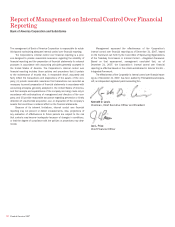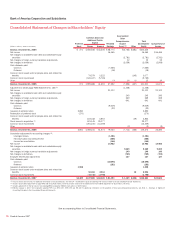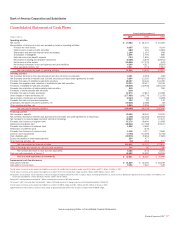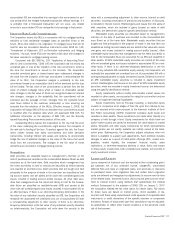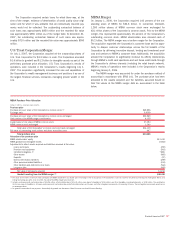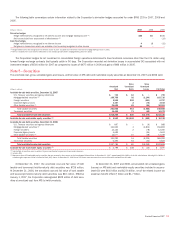Bank of America 2007 Annual Report Download - page 123
Download and view the complete annual report
Please find page 123 of the 2007 Bank of America annual report below. You can navigate through the pages in the report by either clicking on the pages listed below, or by using the keyword search tool below to find specific information within the annual report.accumulated OCI are reclassified into earnings in the same period or peri-
ods during which the hedged forecasted transaction affects earnings. If it
is probable that a forecasted transaction will not occur, any related
amounts in accumulated OCI are reclassified into earnings in that period.
Interest Rate Lock Commitments
The Corporation enters into IRLCs in connection with its mortgage banking
activities to fund residential mortgage loans at specified times in the
future. IRLCs that relate to the origination of mortgage loans that will be
held for sale are considered derivative instruments under SFAS No. 149,
“Amendment of Statement 133 on Derivative Instruments and Hedging
Activities.” As such, these IRLCs are recorded at fair value with changes in
fair value recorded in mortgage banking income.
Consistent with SEC SAB No. 105, “Application of Accounting Princi-
ples to Loan Commitments,” (SAB 105) the Corporation did not record any
unrealized gain or loss at the inception of the loan commitment, which is
the time the commitment is issued to the borrower. The Corporation
recorded unrealized gains or losses based upon subsequent changes in
the value from the inception of the loan commitment. In estimating the fair
value of an IRLC, the Corporation assigns a probability to the loan
commitment based on an expectation that it will be exercised and the loan
will be funded. The fair value of the commitments is derived from the fair
value of related mortgage loans which is based on observable market
data. Changes to the fair value of IRLCs are recognized based on interest
rate changes, changes in the probability that the commitment will be
exercised and the passage of time. Changes from the expected future
cash flows related to the customer relationship or loan servicing are
excluded from the valuation of the IRLCs. Effective January 1, 2008, the
Corporation will adopt SAB 109 for its derivative loan commitments issued
or modified after the adoption date which will supersede SAB 105. For
additional information on the adoption of SAB 109, see the Recently
Issued Accounting Pronouncements section of this note.
Outstanding IRLCs expose the Corporation to the risk that the price
of the loans underlying the commitments might decline from inception of
the rate lock to funding of the loan. To protect against this risk, the Corpo-
ration utilizes forward loan sales commitments and other derivative
instruments, including interest rate swaps and options, to economically
hedge the risk of potential changes in the value of the loans that would
result from the commitments. The changes in the fair value of these
derivatives are recorded in mortgage banking income.
Securities
Debt securities are classified based on management’s intention on the
date of purchase and recorded on the Consolidated Balance Sheet as debt
securities as of the trade date. Debt securities which management has
the intent and ability to hold to maturity are classified as held-to-maturity
and reported at amortized cost. Debt securities that are bought and held
principally for the purpose of resale in the near term are classified as trad-
ing account assets and are stated at fair value with unrealized gains and
losses included in trading account profits (losses). All other debt secu-
rities that management has the intent and ability to hold for the foresee-
able future are classified as available-for-sale (AFS) and carried at fair
value with net unrealized gains and losses included in accumulated OCI on
an after-tax basis. If there is an other-than-temporary deterioration in the
fair value of any individual security classified as AFS, the Corporation will
reclassify the associated net unrealized loss out of accumulated OCI with
a corresponding adjustment to other income. If there is an other-than-
temporary deterioration in the fair value of any individual security classified
as held-to-maturity, the Corporation will write down the security to fair
value with a corresponding adjustment to other income. Interest on debt
securities, including amortization of premiums and accretion of discounts,
is included in interest income. Realized gains and losses from the sales of
debt securities, which are included in gains (losses) on sales of debt
securities, are determined using the specific identification method.
Marketable equity securities are classified based on management’s
intention on the date of purchase and recorded on the Consolidated Bal-
ance Sheet as of the trade date. Marketable equity securities that are
bought and held principally for the purpose of resale in the near term are
classified as trading account assets and are stated at fair value with unreal-
ized gains and losses included in trading account profits (losses). Other
marketable equity securities that management has the intent and ability to
hold for the foreseeable future are accounted for as AFS and classified in
other assets. All AFS marketable equity securities are carried at fair value
with net unrealized gains and losses included in accumulated OCI on a net-
of-tax basis. If there is an other-than-temporary deterioration in the fair
value of any individual AFS marketable equity security, the Corporation will
reclassify the associated net unrealized loss out of accumulated OCI with a
corresponding adjustment to equity investment income. Dividend income on
all AFS marketable equity securities is included in equity investment
income. Realized gains and losses on the sale of all AFS marketable equity
securities, which are recorded in equity investment income, are determined
using the specific identification method.
Equity investments without readily determinable market values are
recorded in other assets, are accounted for using the cost method and are
subject to impairment testing if applicable.
Equity investments held by Principal Investing, a diversified equity
investor in companies at all stages of their life cycle from startup to buy-
out, are reported at fair value pursuant to the American Institute of Certi-
fied Public Accountants (AICPA) Investment Company Audit Guide and
recorded in other assets. These investments are made either directly in a
company or held through a fund. Equity investments for which there are
active market quotes are carried at estimated fair value based on market
prices. Nonpublic and other equity investments for which representative
market quotes are not readily available are initially valued at the trans-
action price. Subsequently, the Corporation adjusts valuations when evi-
dence is available to support such adjustments. Such evidence includes
changes in value as a result of initial public offerings (IPO), market com-
parables, market liquidity, the investees’ financial results, sales
restrictions, or other-than-temporary declines in value. Gains and losses
on these equity investments, both unrealized and realized, are recorded in
equity investment income.
Loans and Leases
Loans measured at historical cost are reported at their outstanding princi-
pal balances net of any unearned income, charge-offs, unamortized
deferred fees and costs on originated loans, and premiums or discounts
on purchased loans. Loan origination fees and certain direct origination
costs are deferred and recognized as adjustments to income over the lives
of the related loans. Unearned income, discounts and premiums are amor-
tized to interest income using methods that approximate the interest
method. Subsequent to the adoption of SFAS 159, on January 1, 2007
the Corporation elected the fair value option for certain loans. Fair values
for these loans are based on market prices, where available, or dis-
counted cash flows using market-based credit spreads of comparable debt
instruments or credit derivatives of the specific borrower or comparable
borrowers. Results of discounted cash flow calculations may be adjusted,
as appropriate, to reflect other market conditions or the perceived credit
risk of the borrower.
Bank of America 2007
121



